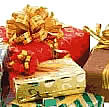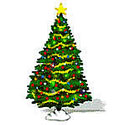| Admin |
| Home Contents email |
| H&S Policy Safeguarding |
| The Church in the World |
| Faith / Church |
| Things Past |
| People & Features |
Seasons and Festivals
Major Festivals

As well as the seasons and major festivals, the church celebrates several 'Special Days' throughout the year to remember, honour or support our work in God's world. Celebration of the "Special Days" is usually optional, Christians chose which they want to remember. (Return to top)

Father Christmas or Santa Claus: Probably the most universal symbol of Christmas is the merry man in the red suit and white beard, known by different names in different countries but in the UK and America as Father Christmas or Santa Claus. Both names have come to mean much the same but they have different origins. Father Christmas traditionally brings the presents to good children at Christmas, which he carries in a large sack, travelling through the sky on a sleigh pulled by reindeer and coming down the chimney to deliver them into stockings or sacks left out for that purpose. (This tradition gets difficult to explain to children in modern houses with no chimney)! (Return to top)
'Father Christmas' arose around 1616 as a man who celebrates the merriness of Christmas in defiance of the Puritans after the English civil war. The Puritans had banned the celebration of Christmas because they saw it as pampering to non-Christian ideas, and Father Christmas was a reaction to this dowdiness. (Return to top)
'Santa Claus' is older and is derived from Saint Nicholas of Myra (Myra is now part of modern Turkey), a bishop around 320AD. He gained a reputation for secret gift-giving, such as putting coins in shoes that had been left them out for him. The English name comes from the German 'Sankt Niklaus' and the Dutch 'Sinterklaas'. (Return to top)
Christmas Presents


Again at the time of the English civil war, Christmas Trees were banned (by Oliver Cromwell) as a 'heathen tradition' detracting from the Word of God, but most churches now have a Christmas Tree, either inside or outside the building. Some even have a 'Christmas Tree Festival' with many trees and a range of decorations, often collecting money for viewing them, which is then given to charity. (Return to top)
Christmas Cards

Christmas Crackers

Christmas Dinner

 St Mary's Church, Dymock
St Mary's Church, Dymock